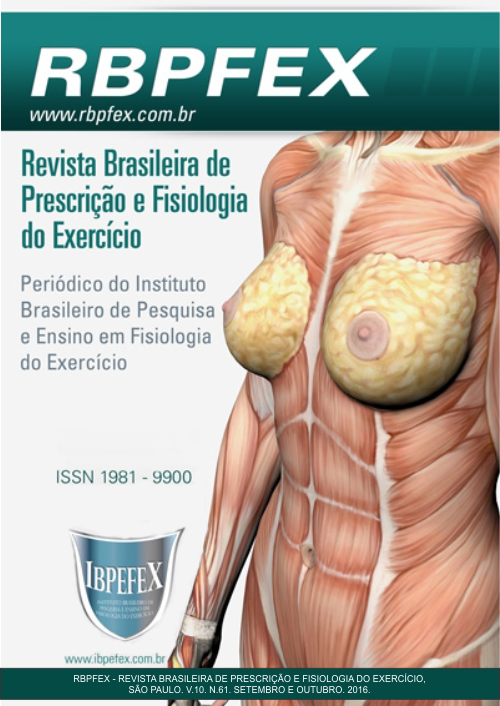Pilates Method: hemodynamic responses before a workout
Abstract
The Pilates method created by German Joseph H. Pilates during World War I had its recognition only in the 80s in the United States when it was used for the rehabilitation of athletes and dancers. The Pilates understand the basics of concentration, control,precision, centering, breathing and fluid movements, is considered a resistance exercise that uses specific devices as overload, body weight, elastic, among others. To better monitoring of these activities, the control variables such as heart rate, blood pressure, double product, perceived exertion as well as neuromuscular and biochemical changes become important today. The study was conducted with 06 individuals of both genders, and to evaluate the hemodynamic response to a workout in Pilates. The mensuras variables were heart rate, blood pressure and double product. Training lasted an hour with execution of 15 exercises with 10 repetitions performed on the ground and specific devices of the method. The variables were measured at the end of each year, the main results, a significant increase of the variables analyzed, except diastolic blood pressure.
References
-American College of Sports Medicine position stand. Quantity and quality of exercise for developing and maintaining cardiorespiratory, musculoskeletal, and neuromotor fitness in apparently healthy adults: guidance for prescribing exercise. Med Sci Sports Exerc. Vol. 43. 2011. p. 1334-1511.
-Bittencourt, P.F.; Sad, S.; Pereira, R.; Machado M. Efeitos do Exercício Contra a Resistência em Diferentes Intensidades nas Variações Hemodinâmicas de Adultos Jovens. Rev. Port. Cardiol, p. 55-64. 2008.
-Borrensen, J.; Lambert, M.L. The quantification of training load, the training response and the effect on performance. SportsMed. Vol. 39. Num. 9. 2009. p. 779-795.
-Bryan M.; Hawson S. The Benefitsof Pilates Exercise in Osthopaedic Rehabilitation. Tech Orthop. Num. 18. 2003. p. 126-129.
-Coutts, A.J. Planning and monitoring training loads during the competitions phase in team sports. Strengthand Conditioning journal, Australia. 2007.
-Farinati, P.T.V.; Assis, B.F.C.B. Estudo da Frequência Cardíaca, Pressão Arterial e Duplo Produto em Exercícios Contra Resistência e Aeróbio Contínuo. Rev. Brasileira de Atividade Física e Saúde. Vol. 5. Num. 2. 2000.
-Kolyniak, I.; Cavalcanti S.M.B.; Aoki, M.S. Avaliação isocinética da musculatura envolvida na flexão e extensão do tronco: efeito do método Pilates. Rev Bras Med Esporte. Vol. 10. 2004. p. 487-490.
-Lima, M. C. S.; e colaboradores. Proposta de Teste Incremental Baseado na Percepção Subjetiva de Esforço para Determinação de Limiares Metabólicos e Parâmetros Mecânicos do Nado Livre. Revista Brasileira de Medicina do Esporte. Vol. 12. Num, 5. 2006.
-Magalhães, F.; Albuquerque, A. P.; Pyrrho, C.; Navarro, F. Comportamento da pressão arterial e da frequência cardíaca em uma aula utilizando método Pilates. Revista Brasileira de Prescrição e Fisiologia do Exercício. Vol. 3. Num. 13. 2009. p. 16-21. Disponível em: <http://www.rbpfex.com.br/index.php/rbpfex/article/view/164/167>
-McArdle, W.D.; Katch, F.I.; Katch V.L. Fisiologia do Exercício, Nutrição, Energia e Desempenho Humano. Guanabara Koogan. Rio de Janeiro. Guanabara Koogan. 2010.
-Meneses Jr., J.R.; e colaboradores. Respostas hemodinâmicas durante e após sessão de Pilates em comparação com exercício aeróbico e resistido. Rev Bras Ativ Fis Saúde. Vol. 19. Num. 6. 2014. p. 732-734.
-Miranda, L.B.; Morais, P.D.C. Efeito do método Pilates sobre a composição corporal e flexibilidade. Revista Brasileira de Prescrição e Fisiologia do Exercício. Vol. 3. Num. 13. 2009. p. 16-21. Disponível em: <http://www.rbpfex.com.br/index.php/rbpfex/article/view/138/140>
-Muscolino, J.; Cipriani S. Pilatesand “Powerhouse” I. J Body Mov Ther. Vol. 8. 2004. p. 15-24.
-Oliveira, R.G.; e colaboradores. O significado da prática do método pilates para as praticantes. Rev. Bras. Cienc. e Mov. Vol. 23. Vol. 3. 2015. p. 47-52.
-Pires, D.C.; Sá, C.K.C. Pilates: Notas Sobre Aspectos Históricos, Princípios, Técnicas e Aplicações. Rev. Digital Buenos Aires. Num. 91. 2005.
-Polito, M.D.; Farinatti, P.T.V. Respostas de Freqüência Cardíaca, Pressão Arterial e Duplo Produto ao Exercício Contra Resistência: Uma Revisão da Literatura. Rev. Port. De Ciências do Desporto. Vol. 3. Num. 1. 2003.
-Santos, M.; Cancelliero, K.M.; Arthur, M.T. Efeito do método Pilates no Solo sobre parâmetros respiratórios de indivíduos saudáveis. R. bras. Ci. E Mov. Vol. 23. Num. 1. 2015. p. 24-30.
-Siqueira, R.B.G.; e colaboradores. Avaliação do equilíbrio estático de idosas pós-treinamento com método pilates. Rev. Bras. Cien. e Mov. Vol. 17. Num. 4. 2009. p. 25-33.
-Simão, R.; Polito, M. D.; Lemos, A. Comportamento do Duplo Produto em Diferentes Posições Corporais nos Exercícios Contra Resistência. Fit. Perf. J. Rio de Janeiro. 2003.
-Vaz, A. R.; Liberali, R.; Da Cruz, T. M. F.; Netto, M. I. A.O método Pilates na melhoria da flexibilidade -Revisão Sistemática. Revista Brasileira de Prescrição e Fisiologia do Exercício. Vol. 6. Num. 31. 2012. p. 25-31. Disponível em: <http://www.rbpfex.com.br/index.php/rbpfex/article/view/335/358>
Authors who publish in this journal agree to the following terms:
- Authors retain the copyright and grant the journal the right of first publication, with work simultaneously licensed under the Creative Commons Attribution License BY-NC which allows the sharing of the work with acknowledgment of the authorship of the work and initial publication in this journal.
- Authors are authorized to enter into additional contracts separately for non-exclusive distribution of the version of the work published in this journal (eg, publishing in institutional repository or book chapter), with acknowledgment of authorship and initial publication in this journal.
- Authors are allowed and encouraged to post and distribute their work online (eg, in institutional repositories or on their personal page) at any point before or during the editorial process, as this can bring about productive change as well as increase impact and impact. citation of published work (See The Effect of Free Access).






